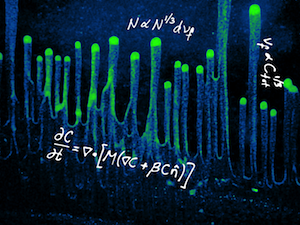RESEARCH
Understanding how cells grow and divide has profound impacts on basic science, biotechnology, and medicine. Despite recent advances in molecular biology and biochemistry, a central challenge remains: bridging the nanometer-scale activities of proteins and the construction of entire cells. Although the mechanisms of bacterial proliferation have been a major focus of research for over a century, it has remained difficult to determine how cellular structure and organization are dynamically controlled due to the central—yet neglected—importance of physical factors.
To address these knowledge gaps, our lab pursues research directions that span from the atomic to the multicellular scales. We investigate the physical nature of intracellular spatial organization, mechanics, and kinetics by leveraging top-down approaches based on cellular-scale observations, bottom-up approaches based on biophysical molecular observations, and computational modeling that connects the two paradigms. Understanding cellular growth and form remains a fascinating, multifaceted challenge with obvious implications for health and disease. In addition to the importance of bacteria as a model system for basic science, uncovering the general physical rules that underlie how bacteria grow and divide will have important applications for controlling bacterial communities and developing novel strategies in synthetic biology.
| Research Topics |
|---|
| Phototaxis of cyanobacterial communities |
 Although much of our work focuses on single-cell growth, communities of bacterial cells exhibit social behaviors that single cells cannot engage in alone. These behaviors are often a product of direct interactions that allow cells to communicate with each other. In the unicellular photosynthetic cyanobacterium Synechocystis, groups of cells collectively move along a surface toward a light source in characteristic patterns. We have shown that cells indirectly interact by secreting a supstance that allows them to move more rapidly and to follow the paths left by other cells (Ursell et al., 2013). We developed a biophysical model demonstrating that this form of interaction is sufficient to reproduce our experimental observations. These studies indicate that physical modification of the cellular microenvironment can act as a “mechanical” quorum-sensing signal, and may play an important role in inducing group behaviors in other systems. These studies hold promise for the synthetic biology of multicellular function, with potential applications for environmental remediation, transport, and scaffolding.
Although much of our work focuses on single-cell growth, communities of bacterial cells exhibit social behaviors that single cells cannot engage in alone. These behaviors are often a product of direct interactions that allow cells to communicate with each other. In the unicellular photosynthetic cyanobacterium Synechocystis, groups of cells collectively move along a surface toward a light source in characteristic patterns. We have shown that cells indirectly interact by secreting a supstance that allows them to move more rapidly and to follow the paths left by other cells (Ursell et al., 2013). We developed a biophysical model demonstrating that this form of interaction is sufficient to reproduce our experimental observations. These studies indicate that physical modification of the cellular microenvironment can act as a “mechanical” quorum-sensing signal, and may play an important role in inducing group behaviors in other systems. These studies hold promise for the synthetic biology of multicellular function, with potential applications for environmental remediation, transport, and scaffolding.
Maintenance of motility bias during cyanobacterial phototaxis.
Chau RM, Ursell T, Wang S, Huang KC†, Bhaya D†.
Biophys J. 2015 Apr 7;108(7):1623-32. doi: 10.1016/j.bpj.2015.01.042.
†Co-corresponding authors
Motility enhancement through surface modification is sufficient for cyanobacterial community organization during phototaxis.
Ursell T*, Chau RM*, Wisen S*, Bhaya D†, Huang KC†.
PLoS Comput Biol. 2013;9(9):e1003205. doi: 10.1371/journal.pcbi.1003205. Epub 2013 Sep 5.
*Co-first authors †Co-corresponding authors